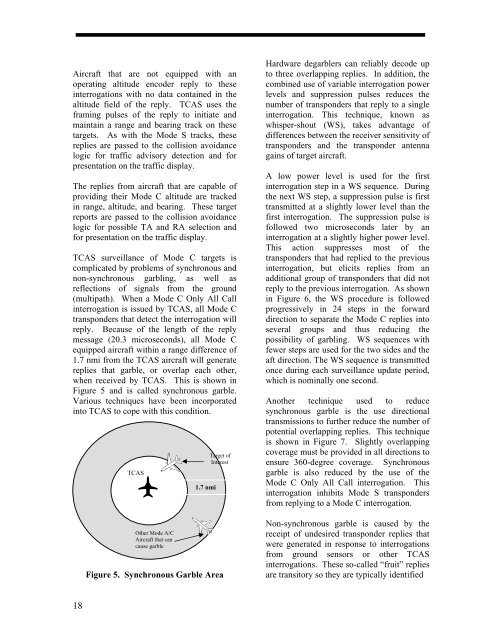Create successful ePaper yourself
Turn your PDF publications into a flip-book with our unique Google optimized e-Paper software.
Aircraft that are not equipped with an<br />
operating altitude encoder reply to these<br />
interrogations with no data contained in the<br />
altitude field of the reply. <strong>TCAS</strong> uses the<br />
framing pulses of the reply to initiate and<br />
maintain a range and bearing track on these<br />
targets. As with the Mode S tracks, these<br />
replies are passed to the collision avoidance<br />
logic for traffic advisory detection and for<br />
presentation on the traffic display.<br />
The replies from aircraft that are capable of<br />
providing their Mode C altitude are tracked<br />
in range, altitude, and bearing. These target<br />
reports are passed to the collision avoidance<br />
logic for possible TA and RA selection and<br />
for presentation on the traffic display.<br />
<strong>TCAS</strong> surveillance of Mode C targets is<br />
complicated by problems of synchronous and<br />
non-synchronous garbling, as well as<br />
reflections of signals from the ground<br />
(multipath). When a Mode C Only All Call<br />
interrogation is issued by <strong>TCAS</strong>, all Mode C<br />
transponders that detect the interrogation will<br />
reply. Because of the length of the reply<br />
message (20.3 microseconds), all Mode C<br />
equipped aircraft within a range difference of<br />
1.7 nmi from the <strong>TCAS</strong> aircraft will generate<br />
replies that garble, or overlap each other,<br />
when received by <strong>TCAS</strong>. This is shown in<br />
Figure 5 and is called synchronous garble.<br />
Various techniques have been incorporated<br />
into <strong>TCAS</strong> to cope with this condition.<br />
<strong>TCAS</strong><br />
Other Mode A/C<br />
Aircraft that can<br />
cause garble<br />
1.7 nmi<br />
Target of<br />
Interest<br />
Figure 5. Synchronous Garble Area<br />
Hardware degarblers can reliably decode up<br />
to three overlapping replies. In addition, the<br />
combined use of variable interrogation power<br />
levels and suppression pulses reduces the<br />
number of transponders that reply to a single<br />
interrogation. This technique, known as<br />
whisper-shout (WS), takes advantage of<br />
differences between the receiver sensitivity of<br />
transponders and the transponder antenna<br />
gains of target aircraft.<br />
A low power level is used for the first<br />
interrogation step in a WS sequence. During<br />
the next WS step, a suppression pulse is first<br />
transmitted at a slightly lower level than the<br />
first interrogation. The suppression pulse is<br />
followed two microseconds later by an<br />
interrogation at a slightly higher power level.<br />
This action suppresses most of the<br />
transponders that had replied to the previous<br />
interrogation, but elicits replies from an<br />
additional group of transponders that did not<br />
reply to the previous interrogation. As shown<br />
in Figure 6, the WS procedure is followed<br />
progressively in 24 steps in the forward<br />
direction to separate the Mode C replies into<br />
several groups and thus reducing the<br />
possibility of garbling. WS sequences with<br />
fewer steps are used for the two sides and the<br />
aft direction. The WS sequence is transmitted<br />
once during each surveillance update period,<br />
which is nominally one second.<br />
Another technique used to reduce<br />
synchronous garble is the use directional<br />
transmissions to further reduce the number of<br />
potential overlapping replies. This technique<br />
is shown in Figure 7. Slightly overlapping<br />
coverage must be provided in all directions to<br />
ensure 360-degree coverage. Synchronous<br />
garble is also reduced by the use of the<br />
Mode C Only All Call interrogation. This<br />
interrogation inhibits Mode S transponders<br />
from replying to a Mode C interrogation.<br />
Non-synchronous garble is caused by the<br />
receipt of undesired transponder replies that<br />
were generated in response to interrogations<br />
from ground sensors or other <strong>TCAS</strong><br />
interrogations. These so-called “fruit” replies<br />
are transitory so they are typically identified<br />
18



